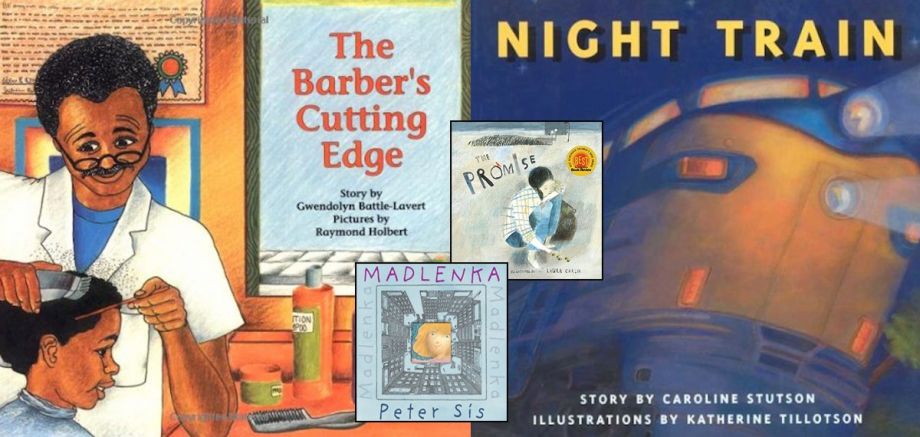Children are still discovering the world spread out before them, and they are fearless about imagining new ones. Playing make-believe is about using the space you are in — a living room, a yard, a forest — to collaboratively create a world with distinctive rules, characters and stories. Call it placemaking in its purest form.
Here is a collection of great books to encourage the imaginative fire. Like my city fiction picks for adults, these picture books bring energy, exuberance and intelligence to questions that first form in our childhood — How did this place come to be? What is possible? Where do I belong? — and examine them through an urban lens.
The Gardener by Sarah Stewart; Illustrator: David Small
Core ideas: urban gardening; Depression-era work and family life
In the summer of 1935, Lydia Grace Finch’s parents are out of work. They send the girl to the unlovely big city to stay with her Uncle Jim “until things get better.” Lydia brings a suitcase full of seeds and stays optimistic, though the city looms drearily above her and Uncle Jim is a grouch. She soon transforms Uncle Jim’s bakery with lush flowers and vegetables, bringing color to the drab surrounding and smiles to the faces of customers. Uncle Jim isn’t impressed, though. He’s too busy working hard to get by. But as spring comes, Lydia works on growing something so extraordinary, even her uncle will find joy in it.
The Gardener is told in a series of letters that Lydia writes home. David Small’s gorgeous watercolors made it a Caldecott Honor Book. Readers will be struck by how the story subtly recognizes the sadness and can-do spirit that emerges when families struggle with unemployment. It is also an empowering look at how anyone, children included, can create beauty where little exists. All you need is a “bit of earth.”
Weslandia by Paul Fleishman; Illustrator: Kevin Hawkes
Core ideas: nonconformism, entrepreneurialism, self-sufficiency
Wesley “sticks out” from the other kids. He dislikes pizza and soda. He wears purple shoes. He doesn’t like football. And in his school, you don’t get away with being eccentric: Wesley is teased. But it is his inability to fit in that stokes the fire behind his majestic summer project: He will create a new civilization in his suburban backyard. Industrious Wesley gathers food from a magical plant called “swist.” He weaves clothing from its fibers, and makes ink and mosquito repellant from its oil. “Weslandia” develops unique systems of shelter, games, tools, counting and writing. Kids who bullied Wesley become curious. They are drawn into participating in his inventive new civilization. In time, this strange and fertile world transforms Wesley’s plain backyard from one that looks identical to all his neighbors to one that decidedly “sticks out.”
In creating a civilization from beginning to end, Weslandia celebrates the joy that comes from hard work, self-sufficiency and a spirited sense of discovery. It affirms how habitual ways of doing things are hardly the only way to do them. Curiosity and persistence are the virtues that make Wesley’s vibrant new city — and his happiness — possible.
Miss Moore Thought Otherwise by Jan Pinborough; Illustrator: Debby Atwell
Core ideas: public libraries, literacy, children’s empowerment
Remember when American children weren’t allowed to touch library books, let alone take them home? I can’t either. We can thank Anne Carroll Moore for that. This is the true story of the pioneering woman who created the first children’s room at the New York Public Library. The little girl from Maine became a librarian because it was one of the few professions open to women. It was a time when the forbidding hush of libraries made children into a nuisance. Miss Moore had better ideas. Why not have kid-pleasing spaces, where silence was not the only option? What about getting rid of dull unwanted children’s books and finding lively stories?
Readers young and old will take heart in how Miss Moore’s stubbornness, respect for children and commitment to civic ideals changed the world. She made sure the children’s room was filled with art, color, window seats, child-size furniture, visiting authors and artists, and, of course, excellent books. Nowadays, it’s hard to imagine them any other way. Re-visiting the time when this was radical is an inspiration. Miss Moore Thought Otherwise is, naturally, best paired with a trip to the your neighborhood library.
Tar Beach by Faith Ringgold
Core ideas: transcending racism, labor rights, civic history
Eight-year-old Cassie dreams of the freedom to go wherever she likes. Her wish comes true one night on “tar beach” — the rooftop of her family’s Harlem apartment building. The stars lift up Cassie and she flies above 1939 New York City. She sees the George Washington Bridge, which her father helped to build, and imagines wearing it as a necklace. She sees the union building that wouldn’t allow her father to join because of his race, and imagines giving it to him as a gift. She also claims the ice cream factory, because … well, she just likes ice cream.
“It’s very easy, anyone can fly. All you need is somewhere to go that you can’t get to any other way.” Cassie’s flight shows the common ownership citizens share over their city. It’s also an exultant tale of self-liberation. Tar Beach is illustrated with bright acrylic paintings, echoing the flattened style of the story quilt that was the tale’s original form. The Tar Beach quilts are now in the collections of major museums, including the Guggenheim — fitting, since Ringgold was a significant force in the 1970s movement pushing museums to recognize the accomplishments of black and female artists. Tar Beach is a Caldecott Honor Book and winner of the Coretta Scott King award.
Little Elliot, Big City by Mike Curato
Core ideas: urban isolation, community
With the noise, crowds and buildings that scrape the sky, big cities can be frightening. Little Elliot — pictured as a tiny white elephant with blue and pink polka dots — has quiet habits. He is intimidated by the urban rush, and he is too small to even reach doorknobs. It makes him feel unnoticed, a bother to the strangers who brush by him.
What will it take to make this beautifully drawn 1940s-era New York City feel like home? Well, cupcakes help. And so does a friend. In spare words, Curato shows how helping out someone else is a great way to build community in an overwhelming place. Little Elliott, Big City is especially ideal for young readers who are moving to or visiting a new city.
The Promise by Nicola Davies; Illustrator: Laura Carlin
Core ideas: crime, poverty, nature, sustainability
The story opens on a drab city street. “I lived by stealing from those who had almost as little as I did,” a young thief tells us. But when she tries to steal an old woman’s bag, the owner holds on tight. The woman tells the thief that she can keep the bag so long as she promises to “plant them all.” It turns out the bag is full of acorns. “I held a forest in my arms.” The thief begins planting them throughout the city, along roadways and rubble heaps, abandoned parks and train tracks. The transformation of the acorns into trees doesn’t just change her life — it changes the lives of generations that follow.
“Green spread through the city like a song, breathing to the sky, drawing down the rain like a blessing.” Consider this book, with its mesmerizing chalky art, a window into how our physical environment syncs with our personal histories. Bad beginnings and bleak landscapes do not mean we are fated to unhappy ends. The Promise insists that hope and long-term vision — the generosity of caring for ourselves and our surroundings — has untold power.
Madlenka by Peter Sis
Core ideas: diversity, immigration, community
When little Madlenka circles around her block, she sees the whole world. She meets the Latin American grocer, the Asian shopkeeper, the Indian news vendor, the Italian ice cream man, the German lady who sits by the window and more. While Madlenka spreads the word about her loose tooth to her neighborhood, we see the joy of living in a place that is at once international and intimate.
Die-cut squares, lift-up flaps and detailed illustrations give us a proper window to this world. At Mr. Gaston’s bakery, you can see the Eiffel Tower and French flag outside his window, and when you turn the page, you see an expansive map of Paris landmarks. Pair this book with its follow-up, Madlenka’s Dog, where the imaginative girl, who wishes for a dog of her own, circles the block while walking her pretend pet. Along the way, she listens to stories her diverse neighbors tell about dogs they used to own. Our little friend appears again in Madlenka Soccer Star.
Night Train by Caroline Stutson; Illustrator: Katherine Tillotson
Core ideas: transportation, travel
A boy and his father take an overnight train to see Grandma. It is the first time the boy has ridden a train. Night Train evokes the full sensory experience of the ride, from the hissing doors to the balancing act of carrying paper cups of water down the rattling aisles. The countrysides and lit-up towns whoosh by: meadows, farm animals, apartment buildings, highways, bridges and more.
“Thunder, lightning on the tracks … / Here comes the train! / Watch out. Stand back.” Told in rhythmic poetry, Night Train reads like a lulling song. Dusky over-size drawings, filled with elongated shapes, communicate the romance of train travel with a touch of humor. A good read for little ones before traveling with them by train, but also for those who are fans of Thomas the Tank Engine and his ilk.
The Barber’s Cutting Edge by Gwendolyn Battle-Lavert; Illustrator: Raymond Holbert
Core ideas: community, role models
In Mr. Bigalow’s barber shop, neighbors all come together: “Little boys. Big boys. Young men. And old men. There was even one girl there waiting to get her hair cut.” Not only do the customers come to the barbershop for the special new styles, they also talk, read and play games. When little Rashaad visits Mr. Bigalow, he tries to stump him with hard words on his vocabulary list. But Mr. Bigalow can define every one — with a little help from sneak peeks at the dictionary.
A simple and cheery story, illustrated with bright crayon-like drawings, The Barber’s Cutting Edge celebrates the role of community mentorship in cities. It also spotlights barbershops as a warm and spirited neighborhood nexus, and teaches a few good vocabulary words — “bewilderment,” “abolish” — along the way.
Apt. 3 by Ezra Jack Keats
Core ideas: apartment living, disability, art, community
Sam lives in a claustrophobic apartment in the city. Through the thin walls, he can hear voices, snoring and crying babies. But one sound stands out above the rest: a harmonica. Who is playing it? Along with his brother Ben, Sam goes on a search through every floor of the building. In Apt. 3, they discover a blind man who is the source of the music. At first, the boys are frightened: They never met a blind person before. But they warm to the man as he explains that he tells “secrets” with his harmonica — like how he slows down when he passes a certain woman’s door. The man plays his harmonica for Sam and Ben. “He played purples and grays and rain and smoke and the sounds of night.” When Sam asks if the man would like to take a walk with them tomorrow, “the room filled with wild, noisy, happy music.”
By the author and illustrator of The Snowy Day, this 1971 classic features the same beautiful collage-style pictures that give a sense of moody movement to each image. Sam’s red cap especially stands out. Apt. 3 is a tale of cross-generational friendship and the power of creating your own beauty.

Anna Clark is a journalist in Detroit. Her writing has appeared in Elle Magazine, the New York Times, Politico, the Columbia Journalism Review, Next City and other publications. Anna edited A Detroit Anthology, a Michigan Notable Book. She has been a Fulbright fellow in Nairobi, Kenya and a Knight-Wallace journalism fellow at the University of Michigan. She is also the author of THE POISONED CITY: Flint’s Water and the American Urban Tragedy, published by Metropolitan Books in 2018.
Follow Anna .(JavaScript must be enabled to view this email address)










